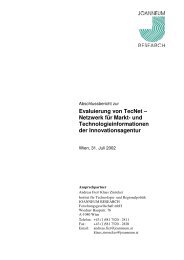roadMAP [PDF, 1.9 MB] - fteval
roadMAP [PDF, 1.9 MB] - fteval
roadMAP [PDF, 1.9 MB] - fteval
You also want an ePaper? Increase the reach of your titles
YUMPU automatically turns print PDFs into web optimized ePapers that Google loves.
Box 25<br />
“Boards” as a qualitative steering element in addition to the standardised monitoring system –<br />
The Case of the Austrian K plus Programme<br />
“Boards” are periodical meetings of all the partners involved in a K plus centre, including the funding<br />
and managing organisations. Boards are no legal bodies according to Austrian corporate law, but due<br />
to the strategic orientation – the board makes decisions or recommendation on issues like budget, new<br />
projects, and new partners – the board has some informal power. Intended as forums for self-<br />
organisation of centres, the boards are successful in creating common understanding and cooperative<br />
culture. The programme manager TIG participates in the boards as a non-voting member and takes a<br />
role as advisor, as observer or as consultant.<br />
From the point of view of the programme manager, boards have been established as an important<br />
instrument for monitoring of culture, behaviour and ongoing developments. Especially in combination<br />
with other more quantitative monitoring it provides a very good information base. One major challenge<br />
is the balance between a purely passive attitude and a too strong steering behaviour. Another<br />
challenge is the handling of vested interest: Participants often pursue individual interests, less often the<br />
interest of the centre. Conclusion: Valuable instrument, but use with care.<br />
One more major topic of discussion was the question of monitoring fatigue. Although most of<br />
the programmes employ modest monitoring systems, HU, ES and esp. SE, AU and CA mention<br />
the point of the „burdensome financial audit“ or the threat of „monitoring fatigue“. CA’s NCEs<br />
complained about the high reporting load which was quite often required by the network<br />
managers and not by the programme management, the NCE directorate.<br />
Monitoring fatigue is especially a problem if the system is neither transparent nor user-friendly.<br />
This is especially the case, if collected data are difficult to gather for the projects and centres,<br />
and if same data collected more than one time for different purposes, and if no one has any<br />
idea what happens with the enormous amount of data collected. MAPs with no problems<br />
concerning monitoring fatigue employ good, relatively simple and robust systems. One special<br />
case to mention in this context is the DE with its CCN programme, where the monitoring system<br />
for R&D projects in the context of the CCN is the one which is used for all R&D grants in<br />
Germany. Therefore, it is well known to the researchers from university and industry, not too<br />
exhaustive but fulfils the requirements to assure accountability.<br />
To avoid monitoring fatigue, a general rule should be applied: Collect all data you use and use<br />
all data you collect.<br />
In conclusion, monitoring strengths of most of the MAPs include: Good financial and milestone<br />
data, which facilitates management of centres and projects. The collection of data allows the<br />
generation of reports on demand concerning all financial aspects that feeds into evaluations and<br />
other ad hoc requests. The bureaucracy and burden for the projects and centres is bearable.<br />
Monitoring weaknesses include: The systems are less flexible when it comes to generating<br />
reports on qualitative matters (here a construction similar to the mentioned “boards” can be<br />
helpful). In most cases, outcome and impact data are not fully reliable. The monitoring systems<br />
are backward oriented and can serve as a basis for decisions on further developments only in a<br />
limited form.<br />
<strong>roadMAP</strong> 93


![roadMAP [PDF, 1.9 MB] - fteval](https://img.yumpu.com/21079876/98/500x640/roadmap-pdf-19-mb-fteval.jpg)

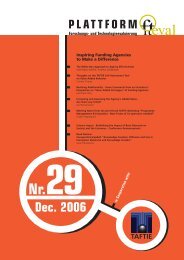
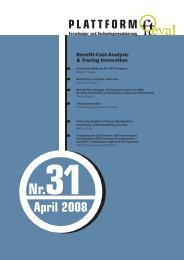
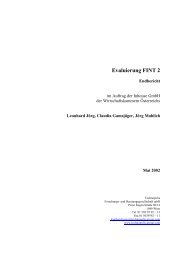
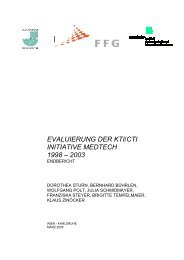
![GuggenbergeronBoku [PDF, 73.4 KB] - fteval](https://img.yumpu.com/21024081/1/184x260/guggenbergeronboku-pdf-734-kb-fteval.jpg?quality=85)
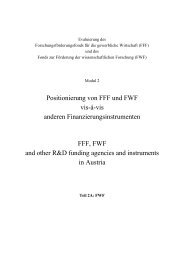

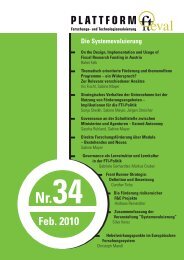
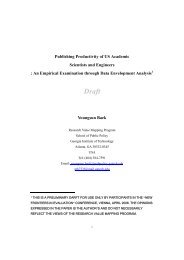
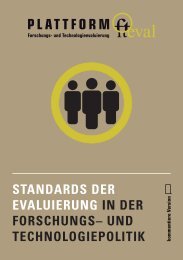
![ITF_Energietechnik [PDF, 39.6 KB] - fteval](https://img.yumpu.com/20959076/1/184x260/itf-energietechnik-pdf-396-kb-fteval.jpg?quality=85)
![Evaluation Standards [PDF, 120.8 KB] - fteval](https://img.yumpu.com/20931509/1/184x260/evaluation-standards-pdf-1208-kb-fteval.jpg?quality=85)
